The holiday season is coming and with it the search for the perfect gift. Luckily, All for Padel offers a wide range of padel accessories, rackets and backpacks that are ideal to surprise your friends and family with. Whether you are looking for a gift under 15 euros or want to give a more luxurious gift, here are some suggestions from our range for every budget.
For the price range up to 15 euros, we have a range of essential accessories that come in handy during the game. Think overgrips for a better grip on the racket, protector tape for racket protection, or even trendy wristbands and handy padel wallets.
In the price range up to 25 euros, we have even more practical options, such as special bags for shoes and rackets along with comfortable hesacore grips that enhance the playing experience.
For those with a budget of up to 50 euros, there are luxury gifts available, such as high-quality overgrips sets, stylish backpacks, spacious weekend bags and even already nice padel rackets that will take your game to the next level.
And for those who really want to stand out, we also offer a selection of premium padel rackets that guarantee ultimate performance. Discover our exclusive collection of top-of-the-range rackets that will amaze and enchant any padel lover.

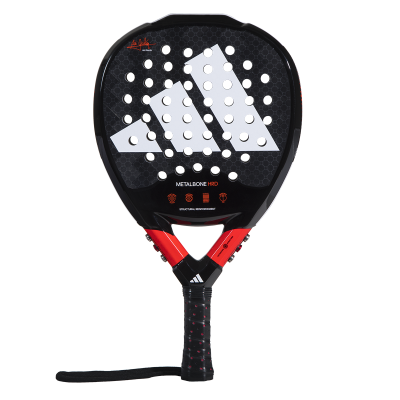

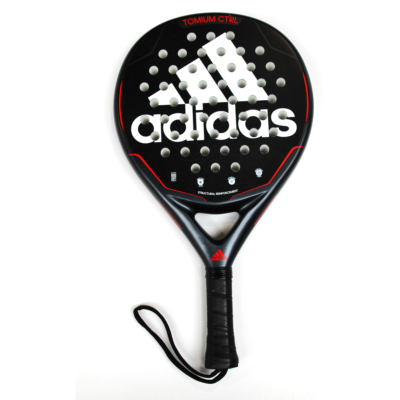


Give a gift voucher and top up for the ultimate gift
At All for Padel Belgium, gift vouchers are also an excellent choice! We offer both digital and physical vouchers, which can be used both online and in our shop.
Maak het geven én ontvangen van cadeaus nog gemakkelijker met Happy Giftlist. Het is de perfecte manier om je verlanglijstje bij te houden tijdens deze feestdagen.
Make this festive period a time full of warmth and being together, and create unforgettable moments with the wonderful gifts from All for Padel Belgium.
Choosing a padel racket is not easy, especially given the large selection of rackets online, in your store and at your club. Together we will look for the best purchase for you!
Which racket is right for me? Does the price determine how strong my racket is? Should a woman play with a different racket than a man? Does the shape of my racket affect how I play? Every beginning padeller struggles with the same questions. Questions to which, unfortunately, there is no one-sided answer. Below we outline step-by-step the basis on which to choose a racket and what to consider in the selection process.
Which racket you buy depends 100% on how often you play and what your ambition is. Are you just starting to play padel? Then it is very important to buy a flexible racket. Have you been playing competition padel for years? Then you better turn to the category with “rigid” rackets. Sounds logical, but how do I choose a racket based on that?
Guidelines how to buy a padel racket:
For the beginning padeller comfort is most important and so we look for a racket made of fiberglass in combination with a SOFT Performance mousse. Pay attention to the shape of the racket and especially the position of the sweet spot. With our rackets the sweet spot is always shown on the racket itself. As a beginning player you should choose a sweet spot in the center of the racket, as this will offer you the most comfort.
Rackets for beginners






The padeller who plays about 2-3x a week should look for a racket that specifically suits his/her playing style. Pay particular attention to the difference between “offensive” and “defensive” rackets. This can be seen in the shape of the racket (rather round = control, rather angular = attack) and the location of the sweet spot. Do you have a tennis history and love to smash? Then you will like an attacking racket. An all-round player will always be fine with a defensive/controlling racket. And for ladies, a Light version is often provided. Which does not exclude ladies from playing with an attacking racket!
Offensive rackets




Control rackets






If you play competition, you need a technical racket. Advanced players know exactly whether they prefer offensive or control rackets. What is important here is that the rackets are made of a stiff material so that they deliver more power when hitting the ball. A beginner player is mainly looking for control, while the advanced player kicks on power.
Rackets for advanced players
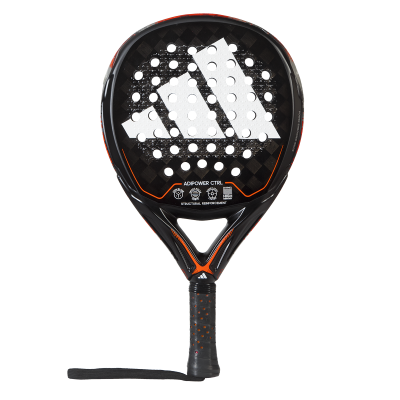





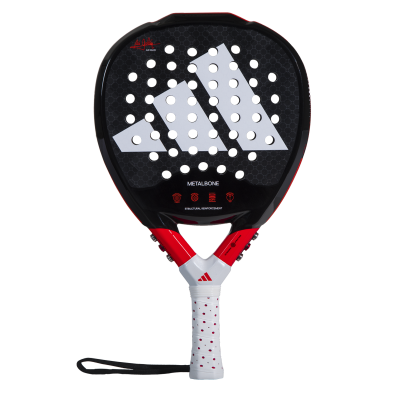

Regardless of the level of the player and the technical characteristics of the racquet, it is incredibly important that a racquet feels comfortable. Do you feel like you are not hitting the ball properly at every ball contact? Then you are probably playing with a racket that does not quite meet your needs (or you better take some more lessons :) )
When buying a racket, always get advice from someone with technical knowledge. As a beginner there is no point in playing with an attacking racket if you don’t know how to smash. So learn to step before you walk. Throughout your (recreational) padel career you will regularly change your racket as you get better at the sport and need another racket.
Have you still not figured out which racket is best for you? Please don’t hesitate to contact us for more info. Woud you like to test some rackets before buying? Please visit one of our testing days or ask advice at your local sport store!
The ‘Weight & Balance’ system, a technology that allows you to add or remove weights at various places in the frame of your racket. This way, you make your racket lighter or heavier, according to your own needs as a player!
The adipower Multiweight rackets are suitable for trained to advanced players. The rackets are composed of an 18K carbon structure with a hard ‘HIGH MEMORY’ mousse. The advantage of combining these two hard materials is that you increase the stiffness of your racket a lot. The stiffer/harder your racket, the more power you can generate with it. So keep those power shots coming! :)
The adipower Multiweight’s frame is reinforced with a double exoskeleton. Adding such an external structure ensures maximum shock absorption at every ball contact.
Tip: the more your racket is externally reinforced, the more shock absorption and thus the less impact on your body!
The racquet features a brand new version of the ‘Weight & Balance’ system.
The Weight & Balance system was first used in the Metalbone series in 2022. Also in 2023, there are weights incorporated into the Metalbone 3.2, Metalbone HRD 3.2 & Metalbone CTRL 3.2.
To incorporate this Weight & Balance technology into the adipower range, we took a completely different approach. Below, we take a closer look at this innovative system and the possibilities it offers you on the field.
The new Mulitweight rackets are constructed like any other adipower racket. Namely: a reinforced carbon frame, with a high-density mousse (= extra resilience) inside. Unlike ‘regular’ rackets, the Multiweights have 3 notches in the frame. Two of these are on the sides of the racket frame (left & right) and the third on the top.
Each of the sides has room for 5 weights, while the top of the racket has room for 3 weights. When purchasing a Multiweight racket, the racket comes standard with 7 movable weights of 1.3g each and 6 covers that you use to fill the remaining ’empty’ holes in your frame. These covers are not meant to add extra weight, they simply prevent water or dust from getting into your racket.
On the left and right sides of the racket, you can add 2 weights each. One at the top of the notch, and one at the bottom in the same notch. At the top of the racket there is room to add 3 weights. Where you add the weights and how you add them will influence the position of your sweet spot and the manoeuvrability of your racket.
With 13 separate elements (read: 7 weights + 6 covers), you can configure your racket in a lot of different ways. Time to look at this in detail:
Focus on power? Then place 3 weights at the top and fill the top 2 holes left and right with a 1.3g screw. With the grey covers, devise the remaining cavities.
Focus on control? Complete the 3 upper cavities with a grey cover so you already eliminate the weight at the top of your racket. Place the 7 weights as close to your hand as possible. Read: in the lower cavities on the left and right side of your racket.
Above was explained how to change the balance of your racquet, but don’t forget that the 7 screws have another function too! By adding or removing 7 x 1.3g, you also experiment with the weight of your racket. Not unimportant if you often play padel.
Do you decide to remove all the weights from the racket? Then you remove 7 x 1.3g = 9.1g and your racket suddenly becomes a light version of the Multiweight.
Tip: an adipower Multiweight racket weighs 345-360g as standard (without weights). If you add 7 x 1.3g, the racket weighs between 355 and 370g, which is the standard weight for a padel racket.
Because you can add and remove weight yourself, this racket has a wide target group. Not only advanced players can handle this racket, also experienced players can master it.
Do you prefer pure power rackets but still want to stay in the ‘light’ category? Then you can simply remove the weights and your racket immediately gains in manoeuvrability. Extremely suitable for women and men with a preference for light rackets OR players prone to injuries.
Still unsure about these new rackets or want to try them out? Come to one of our testevents in 2023 and feel the difference yourself!
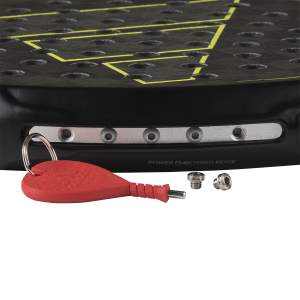

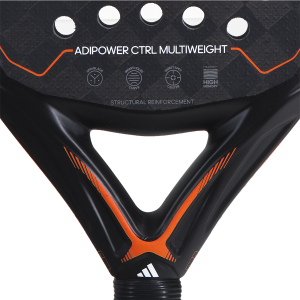



Do’s & don’ts with your racket
One factor you have a direct impact on is how you use and store your racket.
The aspect that distinguishes padel from tennis is that you play it in a fenced area and that you actively use the glass walls and fencing. Some of us take the latter very seriously and are not afraid to hit the fencing with their rackets. Besides the fencing, the ground is also a popular interface when players get frustrated. This hard contact between your racket and an external object is obviously detrimental to your equipment.
The slightest crack or tear in the frame of your racket leads to loss of power. Your racket loses a large part of its resilience and this immediately results in poorer performance on the court. So next time, think twice before throwing your racket against something out of frustration ;)
Does this mean you should avoid the walls of a padel court? Definitely not. Glass walls and fencing are simply part of padel, so don’t go avoiding them on purpose to save your racket!
Can I play padel in the rain?
You can, but preferably use your previous racket instead of your brand new adidas racket. The rain falling on your racket is not so much the problem as the weight of the ball. Every time the ball bounces, the felt fills with water, making the ball heavier as you play. Your racket is made to absorb the impact of a padel ball, but know that a wet ball is much heavier than a dry one. So the impact on your racket is also x times greater than in dry weather. It would not be the first time a racket broke during a game of padel in the rain…
In Belgium, it is humid outside for much of the year and this too requires some attention. Do you play padel in spring or winter? Then remember to bring your racket into the house afterwards. Leaving your racket swinging on the back seat of your car is not a good idea. Water drops will accumulate in the mousse of your racket and cause a weak spot in the blade. So store your racket indoors, preferably horizontally in a room temperature area, so that the water does not settle in one place.
When does my racket need replacement?
Not you yourself, but your fellow players are often the ones who notice that your racket is played up. Do you hear a dull sound with every ball contact? Then the mousse of your racket has lost its resilience and you probably have to hit the ball much harder than necessary (to generate the same power).
Tip: Can’t hear it well, but still want to test whether your racket is ‘on’? Then push into the centre of the mousse with 2 fingers. Can you push the mousse in deeply without effort (= 0.5 – 1.0cm)? Then it’s due for replacement!
DThat sounds like a simple question, but it certainly isn’t!
In this 2-part blog, we answer all your questions about the do’s and don’ts with a padel racket. We end with a few simple tips to extend the life of your racket.
Quality is what you pay for. Is that true for a padel racket?
To answer this question, we start with a bit of technical explanation:
A beginner’s racket is always made of fibreglass. This is a very soft material that mainly offers the player comfort and control. While a racket for advanced players is made of carbon, or in many cases even a combination of carbon and fibreglass. Carbon is a hard material which means you have a short ball contact while playing padel and therefore play harder.
But will your racket last longer if it is made of carbon instead of fibreglass? How cheap or expensive your racket is does not directly determine how long it lasts. All rackets are made for padel play and therefore do not automatically have the purpose of breaking down. How you handle your equipment and how often you play does have a direct influence on the so-called use-by date of your racket.
How many times per week do you play padel?
The lifespan of your racket is directly related to how often you use it. Do you play recreationally, once a week? Then you can easily play with your racket for 12 to 18 months. If you increase your frequency and play three times a week, your racket could be worn out after 8-12 months.
So how come? A racket consists of a solid mousse inside, with a jacket of fibreglass or carbon around it. The more you play, the better your technique becomes and the harder the ball contact is. Playing a lot and hard paddle also means: a lot of impact on the blade of your racket. All these impacts affect the resilience of your material.
Time after time, the resilience of your mousse and fibreglass/carbon deteriorates. The quality of your material does play an important role here. The structure of your racket and the precision with which it is made determine to a great extent how quickly your racket deteriorates.
Actually, you can reason very simply that a fibreglass racket will last as long as a carbon racket if you play with it at the same intensity. So where is the difference?
Suppose you are just starting padel and have no or little experience in racket sports. Then you should look for a soft racket, one that allows you to control the ball. Fibreglass, in other words. A recreational padeller will play padel once or twice a week. At this intensity, a racket can easily last 1 year. If you play once every 14 days, your racket will last even longer.
Are you an experienced player and play competitively? Then we assume you paddle 2-3x a week and use your racket at higher intensity. In addition, we know that a trained player (usually ;) ) is technically strong and plays the ball back harder than a Start2Padeller. So this player needs a carbon racket and will also stress it more by playing more and harder. This player’s racket will be ‘used up’ after 8-12 months, depending on how often and in what conditions he/she plays.
Conclusion: comparing the lifespan of a carbon and fibreglass racket is almost impossible because everything depends on the frequency and conditions in which you play. More important to remember is that you should choose a racket that suits your level!
Sneak peek PART 2:
In the 2nd part of the blog, we take a closer look at the do’s & don’ts with a padel racket as well as answer the question whether you can play padel in the rain. Coming soon….
In July 2022, you absolutely had to be in Koksijde to experience padel. For the first time, an international FIP RISE tournament was organised. Under a beaming sun and under the eye of 100s of supporters, you could enjoy padel at the very highest level!
The first weekend the final rounds of the adidas Padel Tour were played (P100 – P300 ladies, P100 – P300 men, P400 – P700 men). All the finalists of the played preliminary rounds competed there for victory and brought out their best game. In between matches, the court was occupied by some enthusiastic kids who were able to take initiation lessons in padel. In the following days, too, you could get acquainted with padel, with some test moments, initiation lessons, wheelchair padel demonstration matches, an inter-club meeting and much more.


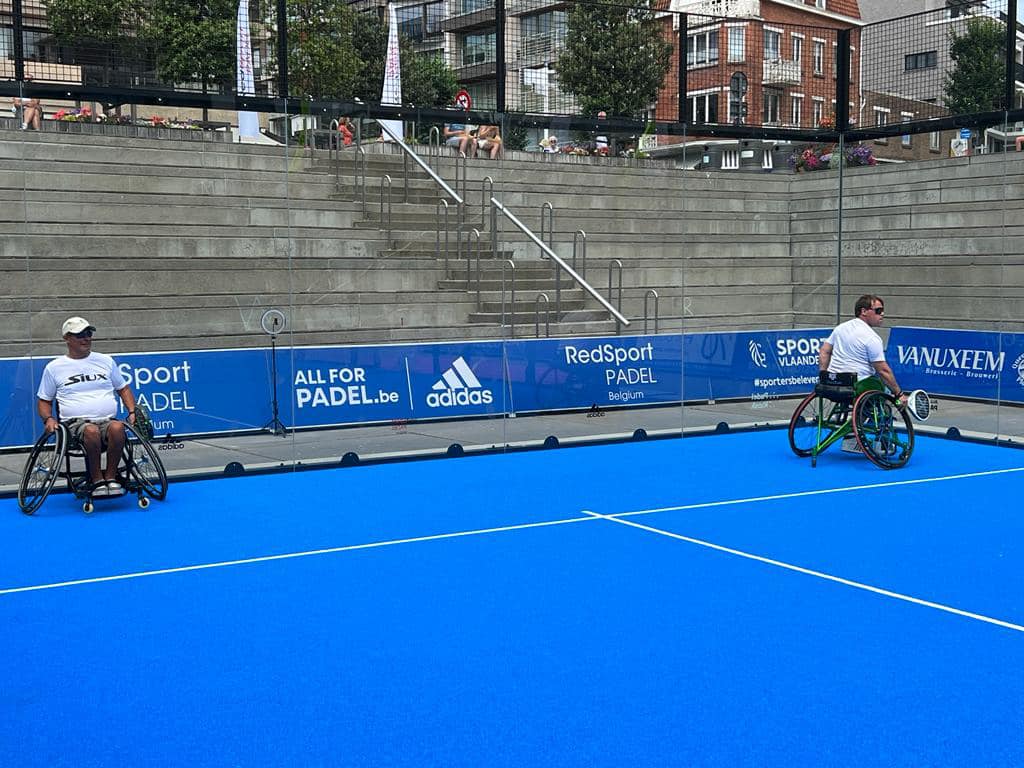

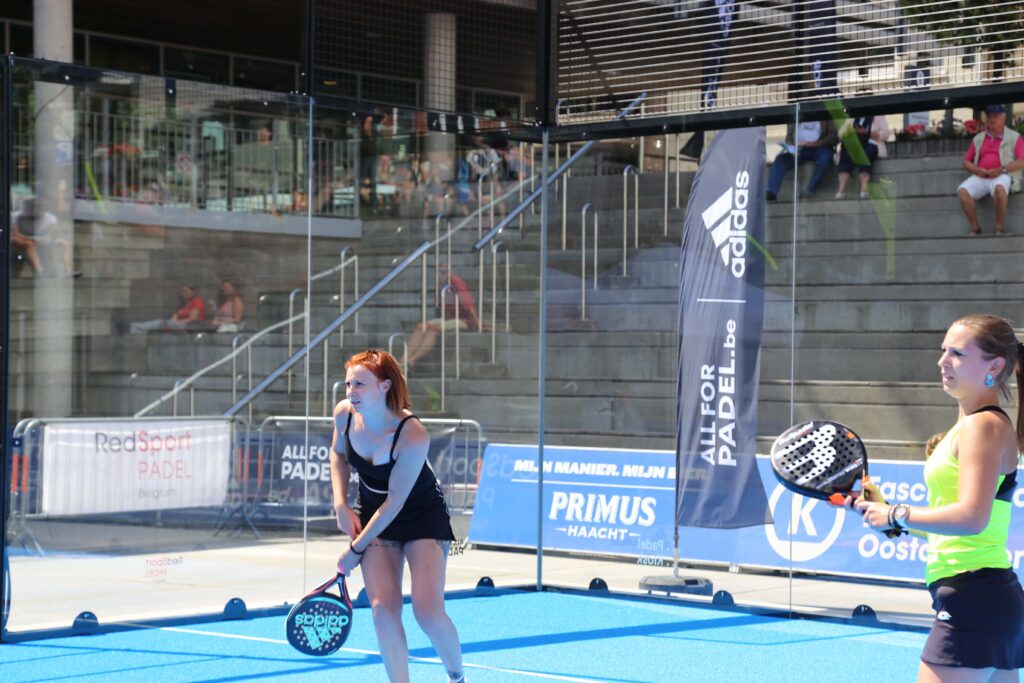

And on Wednesday 13 July, it was finally here! The starting shot was fired for the first official match of the FIP RISE tournament. A Belgian-Spanish duo (Isaac Huysveld & Xavi Rogdriguez Villa) against a Dutch duo (Renee Lindenbergh & Robin Sietsma) kicked off. In the preliminaries played on Wednesday, Thursday and Friday, some Belgian and international top players competed. The weather was kind to us, which made the padel experience all the more special.


And so we went in a straight line towards semi-finals & finals.
The first men’s semi-final was an immediate Belgian affair, with Maxime Deloyer & Jeremy Gala against Clement Geens & Jerome Peeters. A replay of the final at the Belgian championships in early July.
Then Deloyer and Gala had to give way and Geens and Peeters became Belgian champions. In the end, this match was also decided in favour of Clement Geens & Jerome Peeters, who thus advanced to the finals.


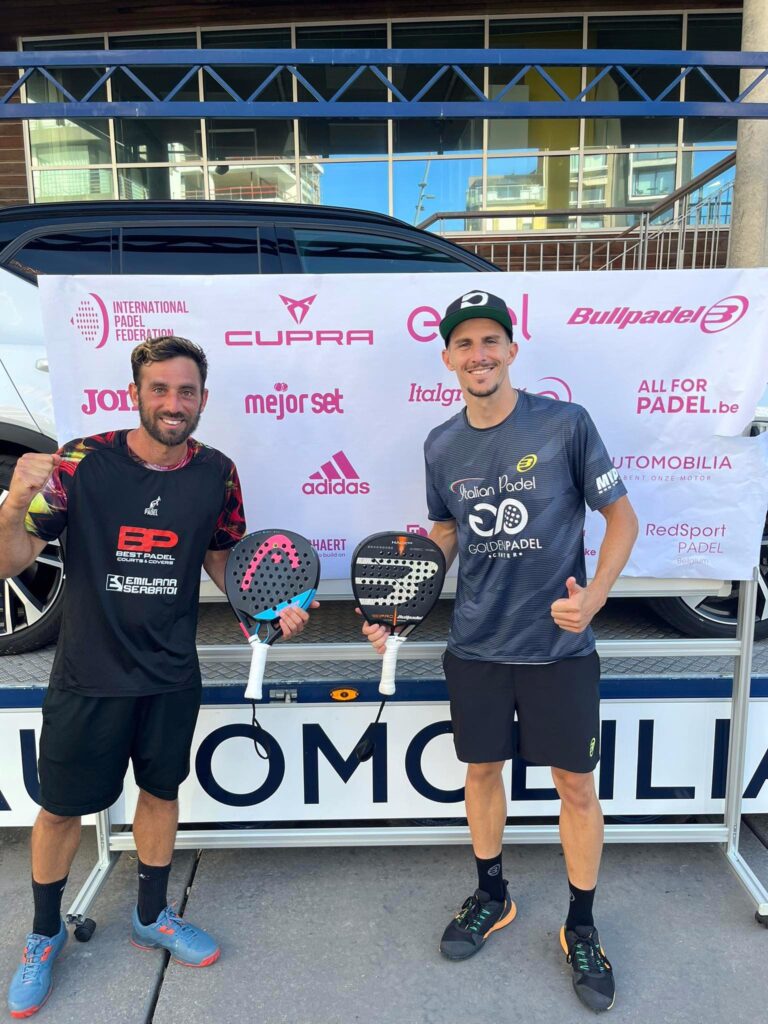

The men’s second semi-final was then again an Italian affair, with Mauro Agustin Salandro & Lorenzo Di Giovanni against Daniele Cattaneo & Riccardo Sinicropi.
All the gentlemen know each other very well, as they often train together. They played each other once before, and then Salandro & Di Giovanni won. Time for revenge thought Cattaneo & Sinicropi, as they won the semi-finals this time!
In the women’s semi-finals, the top of the Belgian women’s padel was gathered, and no more ‘foreigners’ came into play.
In the first semi-final, Ann-Sophie Mestdagh & Helena Wyckaert came out against Elien Boeykens and Babette Wyckaert (yes, the sister of 😊). Both Elien Boeykens and Ann-Sophie Mestdagh come from the tennis world, having already played during the Ladies Trophy tennis tournament in the ‘pit’ of Koksijde. Helena Wyckaert is the highest ranked Belgian in the padel world, and took on her twin sister Babette Wyckaert today. The latter unfortunately lost to her sister & Ann-Sophie Mestdagh, who seemed a size too strong for their opponents.


In the second semi-finals, no less than 3 adidas ambassadors were pitted against each other: Jana Bonnaerens, Noémi Sermant & Michelle Van Mol. Michelle Van Mol became Belgian champion with her fellow player Evelyne Dom earlier this year, and also proved to be the strongest today. Both ladies advanced to the finals.
Sunday, high day! Then the finals were played under a beaming sun and in front of a packed grandstand of supporters.
First it was the ladies’ turn. Michelle Van Mol & Evelyne Dom against Helena Wyckaert & An-Sophie Mestdagh. On paper, the latter two ladies are highest in the ranking. Yet Dom & Van Mol did not give in easily. Blood, sweat and tears flowed and it became a finger-licking match. In the end, Wyckaert & Mestdagh walked away with the victory, but Van Mol & Dom still deserve an honourable mention for their fighting spirit.
That the Belgian men could not underperform was proven by Clement Geens & Jerome Peeters. After an equally blood-curdling match, they won their final against the Italians and in doing so put padel even more on the Belgian map!


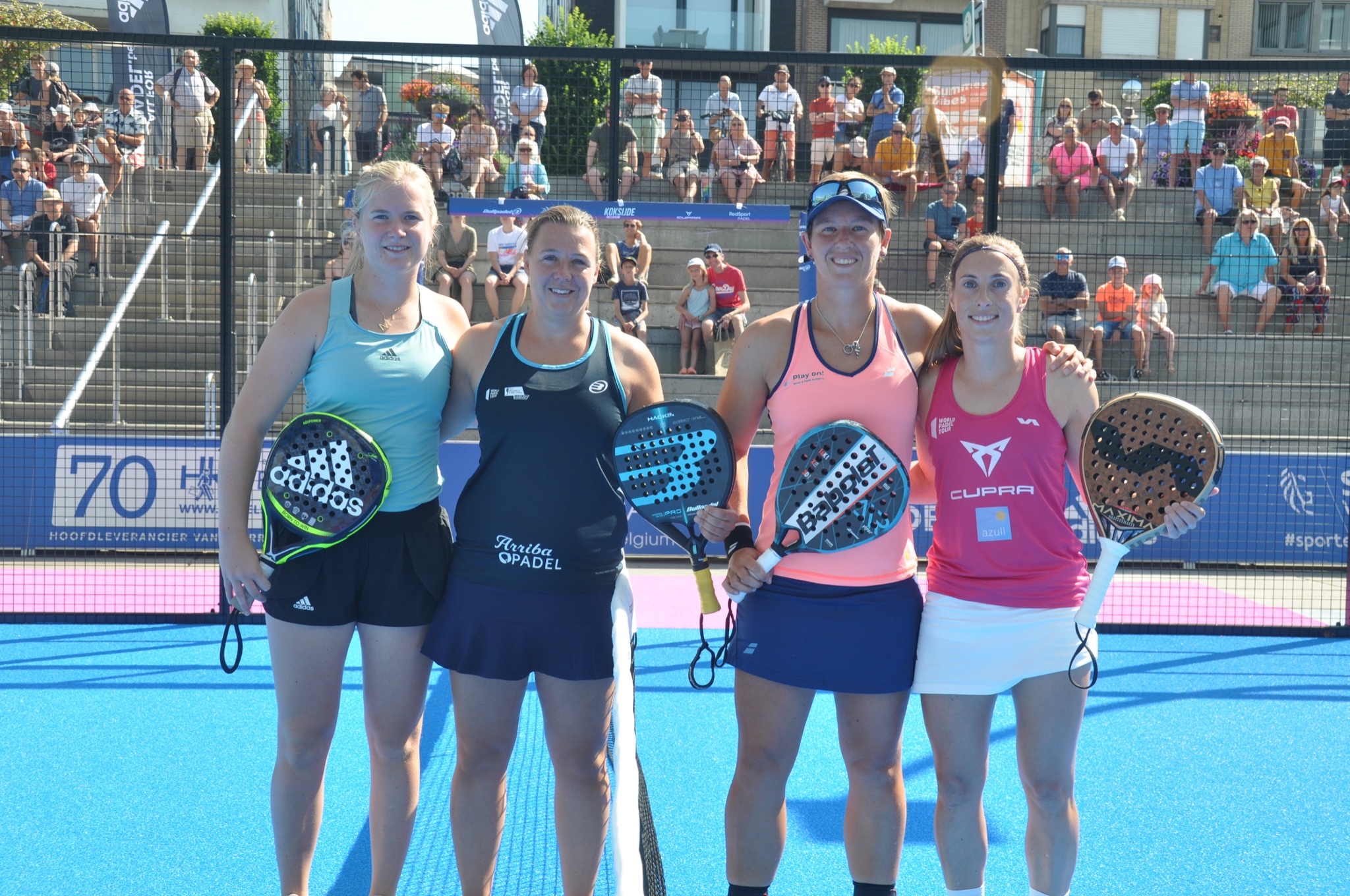

Congratulations to all the winners! Thanks to the municipality of Koksijde, Tennis & Padel Club Koksijde, Tennis & Padel Club Rumbeke, all staff, volunteers and all enthusiastic supporters!
See you next year!
You come across them more and more often in your local padel club. The players who attach an extra ‘tape’ to the handle of their racket. But what is the function of this extra tape and why should you or shouldn’t you use an overgrip?
When you buy a new tennis racket, you choose how wide your handle should be. With a padel racket, you don’t have that option. Grips include a standard size, but our hands are anything but identical!
As a result, the handle may not be suitable for your grip, leading to strokes with less technique and power, or worse, causing injuries to the elbows. A typical example of a grip that is too narrow is that your racket spins away when you volley the ball at the front of the net.
But what exactly is the correct stance? When do you know if a grip is wide enough for you? The golden rule says to leave about 1 cm of space between your fingertips and your palm. Of course, the stance always depends on your personal preference. Some prefer a narrower grip, while other players like to take it extra wide.
Of course, an overgrip is an extra addition to prevent injuries. A good warm-up still remains essential! In a previous blog post, we put together the perfect warm-up just for you!
Overgrips not only ensure a better padel stance, but thanks to our perforated overgrips, you also have good water and sweat absorption, allowing the racket to create an excellent grip feel even in hot and humid temperatures.
Do you find that your hand does not fit the grip so well and do you want extra grip while playing in summer temperatures that will soon arrive? Then our overgrips are definitely for you!


The content of this blog post was provided by RedSport Padel Belgium.. Installer of padel courts in Belgium and also our partner.
That it occasionally snows in Belgium and temperatures increasingly go below zero is no longer a surprise. The question many clubs and players are asking is whether you can play on frozen grass. Does it harm the quality of the grass? Is it dangerous for the players?
The answer to these questions is simple. It is especially important to act quickly when it snows. Don’t wait to clear snow until the next day, but do it as soon as it stops snowing. Below is a roadmap of how to quickly and efficiently ensure snow-free terrains.
After heavy snowfall, it is crucial to remove the snow from the terrain as quickly as possible. You do this initially with a snow shovel (plastic!) and then with a ‘hard’ brush. Do not use brute force here, but remove the snow as gently as possible. The grass under the snow is probably frozen, so be gentle! Remove the snow in straight lines. Don’t try to do this quickly, but make sure to treat it thoroughly with a hard brush. It is especially important to remove as much snow as possible before moving on to phase 2.
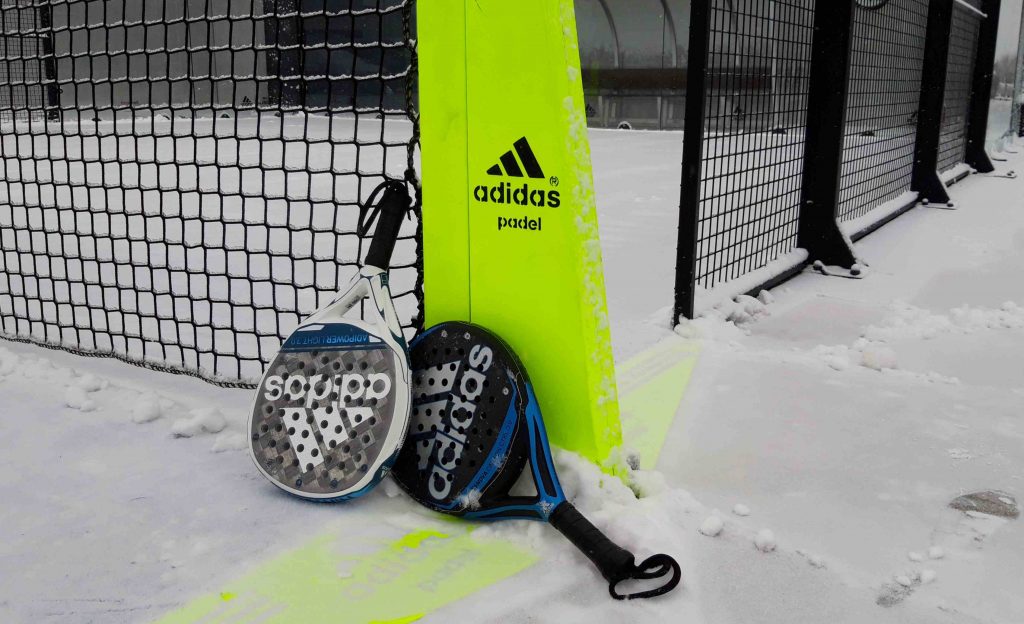

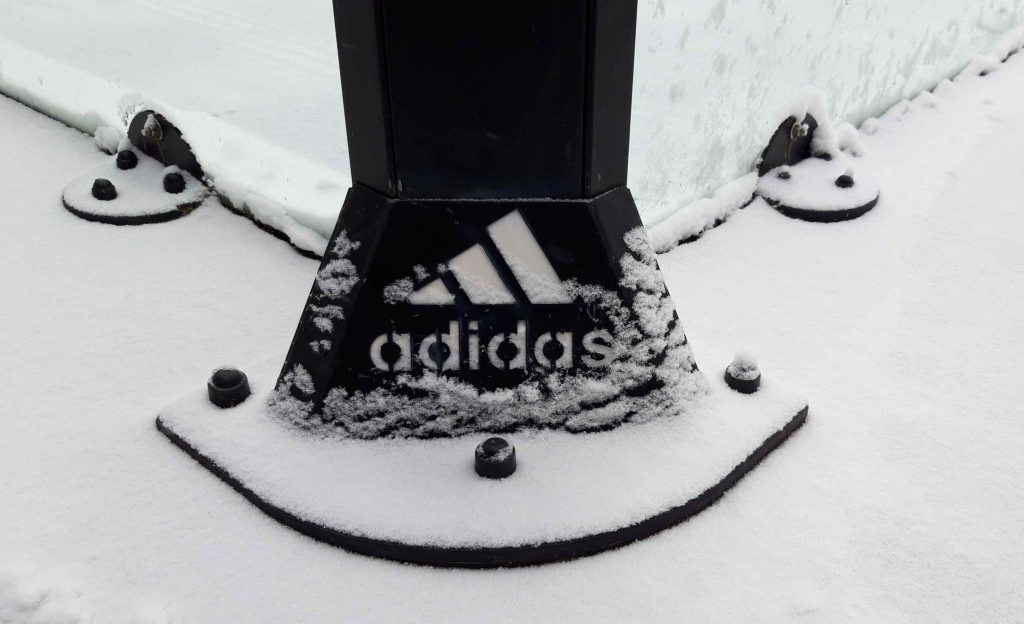

Why is it so crucial to act quickly? If you leave the snow cover for several hours or even a day, it will work its way into the turf. Perhaps the snow will partially thaw only to refreeze afterwards. Clearing the snow (or meanwhile: the ice) afterwards is a tough job, but especially harmful to the grass. Because the grass is frozen in the ice in the meantime, you can permanently damage the turf!
In the 2nd phase of snow clearing, sprinkle the terrain with salt. For this, count on around 5kg of salt per area. It is important to spread the salt granules over the entire surface of the turf, including in the corners and at the bottom of the glass. The grains of salt will cause the top layer of the grass to thaw, preventing the grass fibres from breaking when someone walks on it later.
The above information applies to all grass mats installed by RedSport Padel Belgium, with ‘Tarkett Sport’ as supplier for grass. Does your club have grass from another supplier? Then inform yourself well before using salt to thaw the grass.
The site is snow-free and the grass mostly thawed? Then be sure to check that on the fencing, in the corners, at the bottom of the glass, all snow has been removed. If the snow is not removed thoroughly, it will cause ice to form later. Difficult for those who come to play padel afterwards, but above all: dangerous if people start removing the ice on their own. People will try to do this with hard objects which can damage the structure of the pitch.
Have you completed the above steps? Then your site is once again ready to play for all the enthusiasts who want to brave the cold.
Is it safe to play on frozen ground? With the right footwear, you need not worry. A good padel shoe has a sole with sufficiently deep relief (in tennis, this is called ‘CLAY’). With such footwear, the terrain will feel no different than on a dry day. Have a lot of padel fun!
Still have questions about what equipment you need to clear snow or what method should be used at your club? Do not hesitate to contact RedSport Padel Belgium.
It’s summer and that means the padel season is in full swing. Both at national and international level, the competition calendar is well filled and we will have known it!
Nationaal
This weekend played the 2nd tournament of the ‘Belgian Padel Tour’ in Bayards (Liège). In the men’s competition (P1000), adidas ambassador Nick Braet was present together with his regular partner Jeremy Gala. The duo advanced to the final after an exciting semi-final, where they won convincingly. So two for two for Nick and Jeremy in the Belgian Padel Tour, because the tournament in Arenal Mechelen (July 2020) is also on their record.
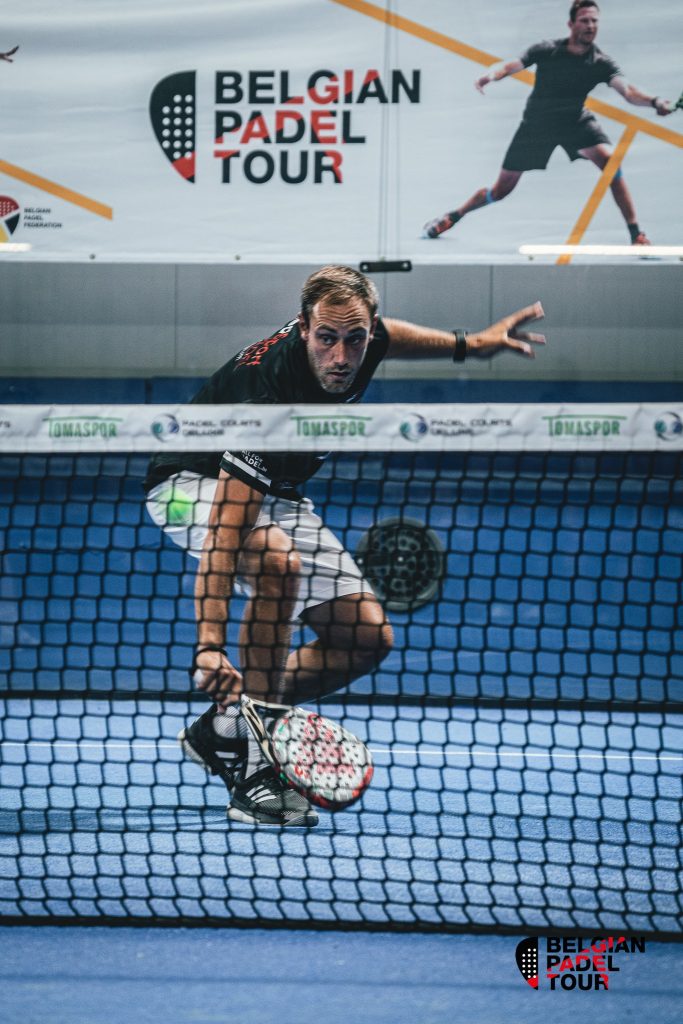

The women (P500) are also doing well in the Belgian Padel Tour. adidas ambassador Laura Bernard played the final yesterday together with Marie Maligo and won it. Because this duo also won the 1st tournament of the Padel Tour in Mechelen, they can add a 2 out of 2 to their name. On to the next tournament in October! The 3rd round of the Belgian Padel Tour will take place at Padel 4U2 in Gentbrugge.
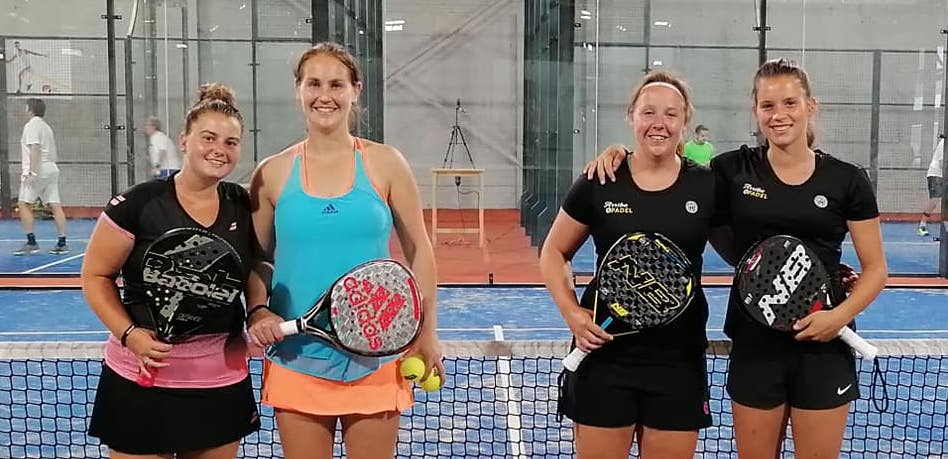

Internationaal
The World Padel Tour, subject to corona measures, continues as normal this summer. Last weekend, the final rounds of the WPT were played in Madrid. And even without an audience, it was all spectacle!
In both the men’s and women’s finals, there were adidas players in the final. On the women’s side, Marta Ortega and Bea Gonzalez tried to dominate the final, but after an exciting battle, they had to acknowledge their superiors to sisters Sanchez-Alayeto. The twins won 6-4 / 4-6 / 4-6.


On the men’s side, it was an exciting battle with Ale Galan and Juan Lebron on one side and Fede Chingotto and Juan Tello on the other. The duo Galan – Lebron finished it off in the 3rd set and went home with the win (6-7 / 6-1 / 6-4). The level that the 4 players topped will have loosened up a lot of living rooms. We now look forward to the first tournament to be played with an audience: the World Padel Tour in Valencia in early September.
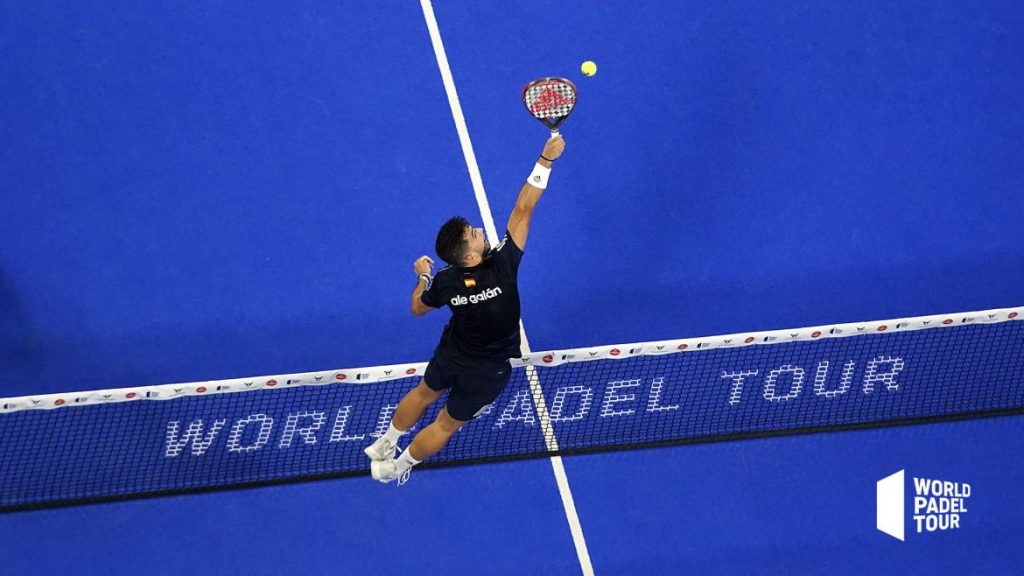

Thank you to all the players who battled again last weekend. Win or lose, it can only make us stronger!
Good luck everyone during your next tournaments! And remember: we are all BORN TO WIN !
Since the beginning of 2020, adidas padel has been contributing to reducing the ecological footprint and creating new forests. And without you even knowing it, you are helping with this too!
Green Padel, a concept that was just an idea a few years ago, has become a reality in 2020. We cannot ignore it, by producing padel rackets and processing them afterwards in waste processing companies, we as a company – just like all other padel brands and sectors – produce an enormous amount of CO2. You also produce that CO2 by moving to the padel club every week. It just happens in Belgium, in Europe, worldwide.
Since problems are meant to be solved, adidas padel has come up with the #GreenPadel concept.
Simply explained: Green Padel is our ‘green’ way to reduce our C02 emissions by producing extra oxygen. In other words: our way of giving something back to nature. Specifically, adidas padel has entered the Reforestum project in the Picos de Europa (Northern Spain). Reforestum literally means ‘reforestation’, which means that we plant trees step by step and thus reduce our ecological footprint.
By ‘we’ I mean everyone who plays with an adidas padel racket. Because how many trees we plant and how fast we do it is up to you! For every adidas racket sold in your local padel club, your favourite sports shop or our website, we as ‘adidas padel Belgium’ donate part of the proceeds to the Reforestum-project. So, thanks to you, a piece of Belgian forest will be located in the Picos de Europa by the end of 2020 :)
Do you receive a thank you for this? Of course. We can’t plant a forest alone, but with the help of an enthusiastic padel clan this goes a lot faster! Therefore: a heartfelt thank you!
Tip: do you buy an adidas racket from the 2020 collection? Then don’t forget to register your purchase via the #GreenPadel label that is attached to your racket. In exchange for this registration, we will treat you to a free padel video on our online All for Padel ACADEMY platform!
All for Padel what? You read that right, the All for Padel ACADEMY. In addition to rackets and courts, we are now completely ready to introduce you our Trainers Academy. More news about this coming soon…
You buy a racket, we plant a tree. Deal?